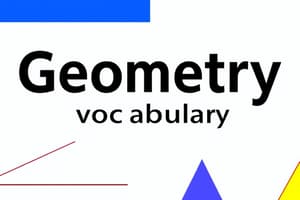Podcast
Questions and Answers
What are collinear points?
What are collinear points?
- Points that do not lie on the same line
- Points that bisect each other
- Points that form a triangle
- Points that lie on the same line (correct)
What are noncollinear points?
What are noncollinear points?
- Points that lie on the same line
- Points that do not lie on the same line (correct)
- Points that are adjacent
- Points that form a right angle
What is a line segment?
What is a line segment?
A part of a line consisting of two points and the set of all points between them.
What are congruent line segments?
What are congruent line segments?
What does the betweenness of points indicate?
What does the betweenness of points indicate?
What defines a ray?
What defines a ray?
What is an angle?
What is an angle?
What are congruent angles?
What are congruent angles?
How can rays be determined to be in a betweenness relationship?
How can rays be determined to be in a betweenness relationship?
What is a right angle?
What is a right angle?
What is an acute angle?
What is an acute angle?
What is an obtuse angle?
What is an obtuse angle?
What is the midpoint of a line segment?
What is the midpoint of a line segment?
What is a segment bisector?
What is a segment bisector?
What is an angle bisector?
What is an angle bisector?
What are complementary angles?
What are complementary angles?
What are supplementary angles?
What are supplementary angles?
What are adjacent angles?
What are adjacent angles?
What defines a linear pair?
What defines a linear pair?
What are vertical angles?
What are vertical angles?
What are perpendicular lines?
What are perpendicular lines?
What is a perpendicular bisector?
What is a perpendicular bisector?
What is the distance between two points?
What is the distance between two points?
What is the distance between a line and a point not on the line?
What is the distance between a line and a point not on the line?
What are parallel lines?
What are parallel lines?
What does it mean for points to be coplanar?
What does it mean for points to be coplanar?
What is a transversal?
What is a transversal?
What is a polygon?
What is a polygon?
What defines a triangle?
What defines a triangle?
What is a scalene triangle?
What is a scalene triangle?
What is an isosceles triangle?
What is an isosceles triangle?
What is an equilateral triangle?
What is an equilateral triangle?
What is an acute triangle?
What is an acute triangle?
What is a right triangle?
What is a right triangle?
What is an obtuse triangle?
What is an obtuse triangle?
What is an equiangular triangle?
What is an equiangular triangle?
What is an exterior angle of a polygon?
What is an exterior angle of a polygon?
What are congruent triangles?
What are congruent triangles?
Flashcards are hidden until you start studying
Study Notes
Points and Lines
- Collinear points lie on the same line; noncollinear points do not.
- A line segment has two endpoints and includes all points between them.
- Congruent line segments are equal in length.
- Betweenness of points defines that if two segments' lengths sum to a third, a point is between the endpoints.
Rays and Angles
- A ray consists of an endpoint and all points extending in one direction.
- Angles form by the union of two rays sharing a vertex; the rays are known as sides.
- Congruent angles share equal measures, while complementary angles sum to 90 degrees.
- Supplementary angles add up to 180 degrees.
Angle Relationships
- Adjacent angles share a vertex, a common side, and have no common interior points.
- A linear pair consists of two adjacent angles whose exterior sides form a straight line.
- Vertical angles are non-adjacent angles formed where two lines intersect.
Lines and Their Intersections
- Perpendicular lines intersect to form right angles (90 degrees).
- A perpendicular bisector divides a line segment into two equal parts at a right angle.
- Distance between points refers to the length of the connecting line segment.
- The distance from a point to a line is measured perpendicularly to the line.
Parallel Lines and Transversals
- Parallel lines lie in the same plane and never intersect.
- A transversal intersects two or more lines at distinct points.
Polygons and Triangles
- A polygon is a closed geometric figure made up of line segments.
- A triangle, a specific type of polygon, has three sides and can be classified by side length or angle measure.
- Types of triangles include scalene (no equal sides), isosceles (two equal sides), equilateral (all sides equal), acute (all angles < 90°), right (one angle = 90°), and obtuse (one angle > 90°).
- An equiangular triangle has all angles equal.
Triangle and Angle Properties
- Exterior angles of a polygon result from the linear pair formed with interior angles.
- Two triangles are congruent if their corresponding angles and sides can be paired as congruent.
Additional Concepts
- Midpoint of a line segment divides it into two congruent segments.
- A segment bisector passes through a segment's midpoint.
- Angle bisectors split an angle into two equal angles.
Studying That Suits You
Use AI to generate personalized quizzes and flashcards to suit your learning preferences.




